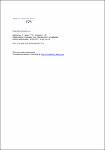Inflammation, Immunity, and Vaccines for Helicobacter
Aebischer, Toni
Meyer, Thomas F.
Andersen, Leif P.
Helicobacter pylori represents the major etiologic agent of gastritis, gastric, and duodenal ulcer disease and can cause gastric cancer and mucosa-associated lymphoid tissue B-cell lymphoma. It is clear that the consequences of infection reflect diverse outcomes of the interaction of bacteria and host immune system. The hope is that by deciphering the deterministic rules – if any – of this interplay, we will eventually be able to predict, treat, and ultimately prevent disease. Over the past year, research on the immunology of this infection started to probe the role of small noncoding RNAs, a novel class of immune response regulators. Furthermore, we learned new details on how infection is detected by innate pattern recognition receptors. Induction of effective cell-mediated immunity will be key for the development of a vaccine, and new work published analyzed the relevance and contribution of CD4 T helper cell subsets to the immune reaction. Th17 cells, which are also induced during natural infection, were shown to be particularly important for vaccination. Cost-efficiency of vaccination was re-assessed and confirmed. Thus, induction and shaping of the effector roles of such protective Th populations will be a target of the newly described vaccine antigens, formulations, and modes of application that we also review here.
Dateien zu dieser Publikation
Keine Lizenzangabe

